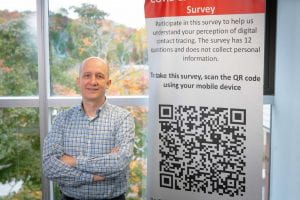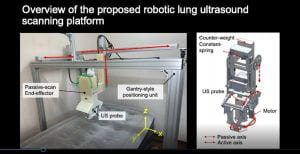COVID-19 Research News Roundup
Toward Secure Digital Contact Tracing
 Investigating the close contacts of people who have tested positive for COVID-19 is a critical part of the strategy to mitigate the virus’s spread. While contact tracing is typically a manual process, “we can make that process easier, faster, and more efficient if we supplement manual contact tracing by digitally obtaining accurate and pin- pointed contact information,” says Patrick Schaumont, professor of electrical and computer engineering.
Investigating the close contacts of people who have tested positive for COVID-19 is a critical part of the strategy to mitigate the virus’s spread. While contact tracing is typically a manual process, “we can make that process easier, faster, and more efficient if we supplement manual contact tracing by digitally obtaining accurate and pin- pointed contact information,” says Patrick Schaumont, professor of electrical and computer engineering.
But some have bristled over the use of digital technology—especially using smartphones—for contact tracing since the technology could reveal personal information, including the movements of people being traced and those they come in contact with. With a $120,000 RAPID grant from the National Science Foundation, Schaumont and colleagues at Virginia Tech are developing a smartphone app that can help conduct contact tracing without risking users’ privacy or personal security.
By tracking a user’s exact location and detecting close encounters with other contact-tracing app users, the smartphone app could determine whether an infected person is close to someone else when they are contagious. The researchers will look for, test, and implement digital technologies that can enable this kind of contact tracing to be done securely and privately, in part by using encryption and cryptography.
—Sharon Gaudin
Detecting COVID with Robotic Ultrasound
 Respiratory illness, among the more serious manifestation of COVID-19, can require repeat scans to allow healthcare providers to monitor a patient’s lung function. Thanks to an innovation by Haichong Zhang, assistant professor in robotics engineering and biomedical engineering, healthcare workers will be able to perform those scans without exposing themselves to the virus.
Respiratory illness, among the more serious manifestation of COVID-19, can require repeat scans to allow healthcare providers to monitor a patient’s lung function. Thanks to an innovation by Haichong Zhang, assistant professor in robotics engineering and biomedical engineering, healthcare workers will be able to perform those scans without exposing themselves to the virus.
Zhang has received a $300,000 grant from the National Institutes of Health (NIH) to build a robotic ultrasound machine to detect disease symptoms in the lungs. It virtually eliminates physical contact between patients and healthcare workers during scans and is a lower cost option, compared with X-ray and CT scan machines. Zhang is working on the innovation with an international team based at Beth Israel Deaconess Medical Center/Harvard Medical School, African University of Science and Technology, Massachusetts College of Pharmacy and Health Sciences, and Yamaha Motor Co. Ltd.
The grant is part of the NIH Common Fund, formed to “address emerging scientific opportunities and pressing challenges in biomedical research that no single NIH Institute or Center can address on its own, but are of high priority for the NIH as a whole.” The Common Fund received $30 million from the 2020 Coronavirus Aid, Relief, and Economic Security (CARES) Act to support new research to prevent or respond to the virus in all parts of the world.
–Colleen Wamback
An Oxygen Sensor Tuned to COVID
The COVID-19 pandemic has put healthcare workers at risk. One study of the U.S. and the U.K. found that front-line healthcare workers face a nearly 12-times greater risk of becoming infected with COVID-19; they’re also at risk of infecting their families and contributing to the virus’s spread in their communities. Early signs of COVID-19 include changes in lung function, which is detectable by looking for changes in dissolved oxygen levels in the blood, a vital indicator of the overall effectiveness of the lungs.
Ulkuhan Guler, assistant professor of electrical and computer engineering and director of WPI’s Integrated Circuits and Systems Lab, is developing a small, wearable blood oxygen sensor that can be worn by healthcare workers and others at high risk of contracting the disease and serve as an early warning device. The sensor (about the size of a Band-Aid) is being developed to be flexible, stretchable, wireless, inexpensive, and mobile—enabling the wearer to be monitored remotely and continuously without an invasive procedure.
The sensor is an outgrowth of work Guler did on a wireless sensor that can measure blood oxygen in hospitalized babies, eliminating the need for them to be tethered to a device and allowing them to be more easily and frequently examined and held. “The electronics we have been developing for the baby oxygen sensor will be the same for COVID patients,” she says, “so we’re in a good position to fine-tune the design for babies and adults. We’re producing prototypes for both at the same time.”




